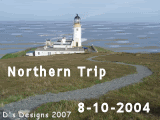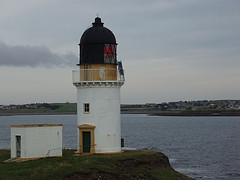
Pretty wet and featureless, isn't it. Suffice to say that I ended up about 2 miles off course, as I found to have gone northeast rather than north. The excuse of a heavy shower is invalid. The other problem you encounter on the moors further north, on the Barvas Hills is quite adequately demonstrated by this picture:

Nice for walking through. And that was after a dry spell. In a wet period, it's a nightmare, where it is perfectly feasible to sink into a bog, without leaving a trace. The interior of Lewis is covered in a layer of peat, some 20 ft / 6 metres thick. This is not a continuous layer, there are some massive crevices in it. Over time, these fill up with water, mosses and other growths. There is a specific type of moss, spaghnum moss, which grows in bogs. The first picture in this post shows some of it, the bright green stuff. As you walk through the moors, it's the vegetation that shows where you can stand - and where you cannot stand.

Another problem, as I already hinted above, is the presence of water. I'm not referring to bogs, but rivers and lochs (lakes). The image above shows Lewis from space - Loch Langavat bottom left, Upper Loch Seaforth bottom right. As well as a myriad of waterways and lochs. There are several ways of coping with those. Bridges would be an obvious solution, you might think. No. Not in the back country. If you want to cross a waterway, you can count yourself very lucky indeed to find a bridge. Stepping stones may be present but more often than not you'll just have to ford. Ford?

Aye, take your boots and socks off and wade through the water. Be very careful though. The water is usually cold, can be fast flowing and deeper than you think. The bottom may be muddy, covered in sharp stones or (worse) slippery boulders.

I took the picture above some 4 miles west of Balallan, just after fording about the most difficult and dangerous river crossing of my walking career. It is the outflow of Loch Langabhat, and you can see the horrendous boulders. It does not show the depth of the water, the speed of its flow or the slipperiness of the submerged stones.
But treat your environment with the respect it deserves, and you should come out the other end in one piece and none the worse but for a pair of filthy boots and soiled trousers.
I've compiled some safety hints for walking, check them out on my Walks page.












That's the answer, to respect the enviroment. We're so cossetted nowadays, people sue councils if they trip over a paving stone that sticks up half an inch! There's nobody to sue in the countryside is there?! It looks really waterlogged up there and quite treacherous in places, not the sort of place you could wander around at night. I wonder how many bodies are in those watery graves, must be quite a few who disappeared in years gone by! Thanks for the link to your safety tips, I'll check them out. Jeannette xx
ReplyDeleteIt all has a bleak beauty ,As you say respect your environment ,my those stones can be sharp Isee you lost some toes! ........Jan xx ;>)
ReplyDelete